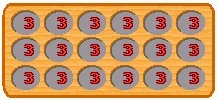Selus → Italian.
| Selus |
| First Description: Richard Pankhurst, 1971 |
| Cycles: One |
| Ranks: Three |
| Sowing: Multiple laps |
| Region: Eritrea |
Selus is a generic name given to mancala games which are played on three-row boards. Apparently, the word derived from Geez selus which means "three".
In 1971, Richard Pankhurst wrote an excellent 53-page article on Ethiopian mancala games, including games from Eritrea, Djibouti and Somalia. He gave the rules of 103 games, of which 12 were three-row games or "Selus".
In the 1970s, Selus was still played in the highlands of Eritrea and in certain regions of modern Ethiopia, notably northern Tigre, Dorzé and Kulu Konta.
This particular variant was reported from the city of Massawa, Eritrea. It was described as Game 13 by Pankhurst.
Rules
The board has 3x6 holes. Initially there are three seeds in each hole. Each player owns the row closest to him and the three holes of the central row at his right hand.
Initial Position
Each move starts with a player emptying the contents of one of his holes that is not a wegue ("wound"). Then, the seeds are dropped one by one into the following holes.

Direction of Sowing
If the last seed falls into an occupied hole other than a wegue, the player takes up its contents and distributes these seeds in a new lap. Let's suppose you start the move in your left corner: the seeds are first distributed in your own back row from left to right, then in your central holes from right to left, afterwards in your opponent's back row from right to left and finally in your opponent's central row from right to left (see the diagram).
It is not permitted to pass a move unless a player has no legal move left.
The move ends if the last seed is dropped into an empty hole. This is called kwah, an onomatopoetic word that imitates the sound of the stone alighting on the board.
Wegues are created when the last seed distributed falls into a hole of three, thus making four seeds. The creator is called the owner of the wound who marks it in a distinctive way. Creating a wegue ends the move. A wegue can be created on either side of the board.
If the last seed of a move is dropped into a wegue, the player captures this seed and, unless the wound was empty, one of the seeds it contained. Capturing is permitted from any wegue, irrespective of the owner. The player must move again (beginning with any hole of his side which is not a wegue) if he captured from a wegue he owns, but must stop moving, if he captured from a wegue owned by his opponent.
Exception:
- The two left-hand holes in a player's back row are called ayemi ("eye"). A player is not permitted to capture from an eye on his side, only from the opponent's side. In that case, he must move again, even if he has captured from an opponent's wegue. If the last seed fell into a wegue in your own ayemi, the move ends.
The creation of a wound is only permitted after the original set-up has been destroyed, i.e. after the first move of a game. If, in the first move, the last seed makes four seeds, they are distributed in another lap.
The game ends when both players have no move left. Each player scores a point for each captured seed and a point for each seed in a wegue owned by him. The player with most points wins.
Strategy
Capturing wegue is crucial. A wegue in your own ayemi is bad for you unless the game has almost ended. Avoid making a wegue in your opponent's holes. Players therefore always attempt to create a wegue in their own holes. If they follow this strategy games become rather short (on the average 17 moves).
Endgame
South to move! Capture as many seeds as possible!
Note: Square holes are wegue.
References
- Cerrato, L.
- Selus. In: Il Fogliaccio degli Astratti 2006; 37 (November): 2 & 6.
- Gering, R.
- Selus and Sadéqa: African Warrior Games. In: Abstract Games Magazine 2003; 4 (16): 16-17, 23.
- Pankhurst, R.
- Gabata and Related Board Games of Ethiopia and the Horn of Africa. In: Ethiopia Observer 1971; 14 (3): 171-172.
Solution
6/1/5/9/3-4-9(+2)-8/1/6(+2)-5/1/6-8-7-8(+2)/1.
Copyright
© Wikimanqala.
By: Ralf Gering.
Under the CC by-sa 2.5.

